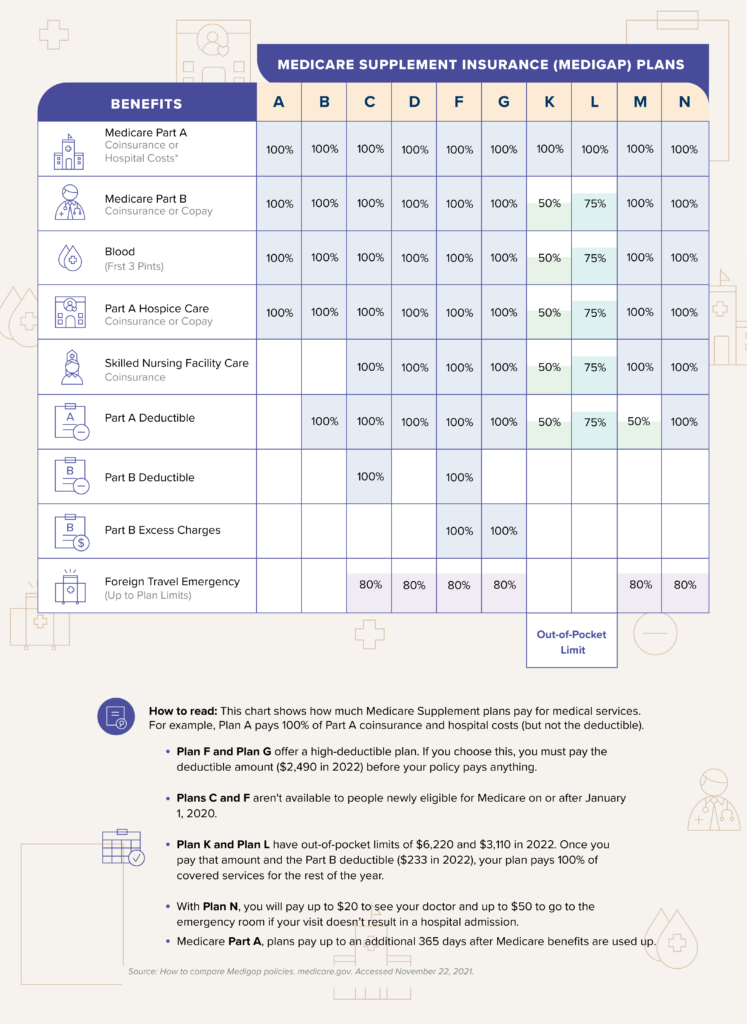What You Need to Know
Original Medicare covers many healthcare expenses, but you’ll still be responsible for fees like copayments and deductibles. A Medigap policy can help to cover these remaining costs.
You must be enrolled in Medicare Parts A and B to qualify for a Medigap policy.
In Hawaii, you can choose from 12 Medigap policies, including two high-deductible plans. Each one offers slightly different coverage.
Original Medicare — which is Medicare Part A and Part B combined — covers many of your healthcare expenses, but it doesn’t cover everything for Hawaii residents. You’ll still be responsible for out-of-pocket fees like deductibles and copayments, and these can add up when you have frequent healthcare needs.
A Medigap policy, also called a Medicare Supplement plan, can help to reduce or even eliminate those remaining expenses. Your Original Medicare will first contribute toward your costs, and then your Medigap policy will help to cover what remains.
When Can You Enroll in Medigap in Hawaii?
Just like traditional health insurance, Medigap has an Open Enrollment Period and it’s easiest to enroll during this time.1 This six-month Open Enrollment Period automatically starts the month you turn 65 and enroll in Medicare Part B. During this time, you can buy any policy, even if you have a preexisting health condition like diabetes.
You can still enroll in Medigap outside of your Open Enrollment Period, but getting a plan can be more complicated. Outside of Open Enrollment, insurance companies can deny you coverage if you have a preexisting condition. An insurance provider can also implement a six-month waiting period and might opt to exclude coverage for a preexisting condition.
Some situations, like moving outside of your current Medicare Advantage Plan’s service area, will qualify you for guaranteed issue rights,2 meaning an insurance company must let you buy a Medigap policy even though you’re outside of your Open Enrollment Period. The insurance provider also can’t increase the price of your policy or exclude a preexisting condition.
Certain circumstances can also qualify you for what’s called a Special Enrollment Period.3 Qualifying events include situations like moving or losing your current coverage. During a Special Enrollment Period, you’ll be able to change your coverage. The types of changes you can make will depend on your qualifying event.
A Word of Advice
Take advantage of your Open Enrollment Period to choose the best Medigap policy for your needs — and to get coverage regardless of preexisting health conditions.
What Are the Most Popular Medicare Supplement Plans in Hawaii?
In Hawaii, you can choose from 12 Medigap plans, including two high-deductible options.4 Coverage, premiums, deductibles, and copayments vary between policy, so you’ll want to carefully research each one to understand exactly what’s included.
Some of the most popular choices are Plan F, G, and N. Note: Plans C and F are not available to anyone who qualified for Medicare after January 1, 2020.
Plan F
Plan F offers the most comprehensive coverage:
- Part A coinsurance and hospital costs
- Part B copays/coinsurance
- Blood (first 3 pints)
- Part A hospice
- Skilled nursing facility
- Part A deductible
- Part B deductible
- Part B excess charges
- Foreign travel emergency – 80%
Plan G
Plan G offers most of the same coverage as Plan F, but it excludes the Part B deductible:
- Part A coinsurance and hospital costs
- Part B copays/coinsurance
- Blood (first 3 pints)
- Part A hospice
- Skilled nursing facility
- Part A deductible
- Part B excess charges
- Foreign travel emergency – 80%
Plan N
Plan N offers similar coverage as Plan G, excluding the Part B deductible and Part B excess charges:
- Part A coinsurance and hospital costs
- Part B copays/coinsurance
- Blood (first 3 pints)
- Part A hospice
- Skilled nursing facility
- Part A deductible
- Foreign travel emergency – 80%
How to Choose a Medicare Supplement Plan in Hawaii?
Each Medigap policy offers different coverage. By choosing a policy that covers the types of healthcare expenses that you have most often, you’ll get the best value out of your plan. When deciding which policy is right for you, you’ll want to balance the plan’s coverage with a premium that you can comfortably afford. A third-party comparison tool like MedicareGuide.com can help you to compare and evaluate plans.
Snippet Render Is Present – D3 cannot be loaded in editor mode. Go to preview or publish mode.

How Much Do Medigap Policies Cost in Hawaii?
Medigap cost and coverage varies between plans. Copays and deductibles also depend on the plan you choose. The following prices reflect a quote for a 65-year-old female nonsmoker in Hawaii. They can give you a rough idea of Medigap plan costs.
- Plan F: Premiums from $137 to $389
- Plan F High Deductible: Premiums from $32 to $46
- Plan G: Premiums from $110 to $368
- Plan G High Deductible: Premiums from $32 to $42
- Plan N: Premiums from $79 to $212
Source: Medicare.gov cost calculator
A Word of Advice
Premiums can vary widely between Medigap plans, but it’s also important to keep in mind the copays and deductibles you’ll pay when you use healthcare services.
Premiums can vary widely between Medigap plans, but it’s also important to keep in mind the copays and deductibles you’ll pay when you use healthcare services.
What If You Want to Change Your Medigap Policy in Hawaii?
While you can change your Medigap policy during your Open Enrollment Period, there are limited chances outside of that timeframe. You can opt for a different plan if you have guaranteed issue rights or a Special Enrollment Period, but the changes that you can make may be limited. This means it’s important to carefully research each plan when you first sign up so that as much as possible, you choose the policy that’s right for your needs and budget.
What Are Alternatives to Medicare Supplement in Hawaii?
Like Medigap, Medicare Advantage plans help to cover some of the costs you’re responsible for with Medicare Part A and Part B.5 Some Medicare Advantage plans also include prescription coverage, which Medigap policies don’t offer.
What Are Medicare Resources in Hawaii?
- The Hawaii State Health Insurance Assistance Program (SHIP) offers free one-on-one Medicare counseling services to connect you with resources in your area and choose the health insurance program that’s right for you.
- The Hawaii Insurance Division investigates complaints about insurance companies and can help you to solve insurance-related issues.
- Med-QUEST, Hawaii’s Medicaid program, can help you to apply for Medicaid, find out about medical services available to you, and access community resources that can help you and your family.
Next Steps
While Medicare covers most of your healthcare expenses, a Medigap policy can help to cover those remaining fees like copayments and deductibles. Your Medigap plan can help to minimize or even eliminate the out-of-pocket costs that you’re responsible for. To learn more, check out How to Choose a Medicare Supplement Plan.

